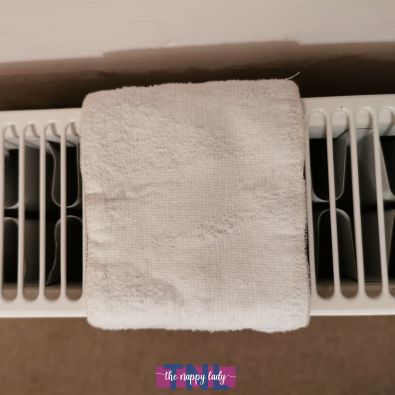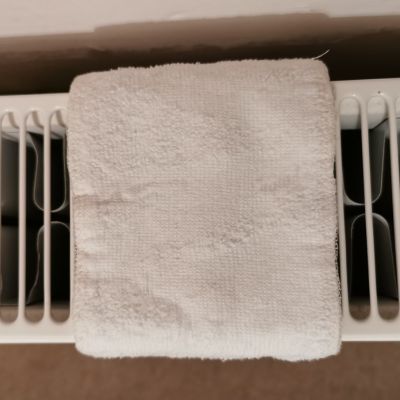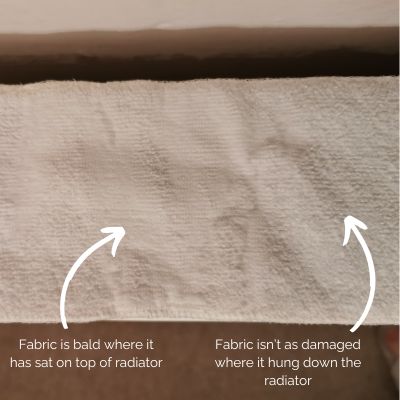Drying Reusable Nappies On A Radiator

Wondering if you can dry your reusable nappies drying on radiator without compromising their quality? My guide will talk you through the pros and cons.
Key Takeaways
-
Radiant heat from radiators offers a convenient option for drying reusable nappies, but it’s essential to consider fabric sensitivity, manage airing to prevent damage, and ensure proper airflow to avoid moisture build up.
-
Alternative drying methods such as heated airers, ceiling drying racks, and tumble dryers on a low heat setting offer energy-efficient and fabric-friendly alternatives to radiators, each with unique benefits like cost savings and space efficiency.
Radiant Heat Drying: The Pros and Cons
When it comes to drying reusable nappies, radiant heat from a trusty radiator can seem like a godsend, especially during those chilly months when it’s already hard at work. However, it’s not all warm and cozy in the realm of nappy drying. Sure, the convenience and cost savings are alluring – imagine drying your nappies on something that’s already running. But beware, as this method requires a keen eye on rotation for even drying but there are real risks of burning fabrics or melting poppers.
Overheating can be the bane of delicate fabrics like bamboo or cotton, considerably shortening the life of your nappies.
Avoid placing nappies directly on a radiator, instead use radiator drying racks as discussed further in this article. Nappies directly placed on radiators are the most at risk of damage.


Portable Oil Filled Radiators
Portable oil filled radiators can get exceptionally hot to the touch and reach temperatures far higher than home central heating system radiators. Do not dry nappies on these they can burn in minutes!
Understanding Fabric Sensitivity
Nappy fabrics are as diverse as the patterns on them. Each has its own temperament when it comes to heat – some can shrug off the warmth of a radiator, while others, like the delicate bamboo, can easily burn. If you cherish your bamboo nappies, steer them clear of direct radiator heat to avert the tragedy of damage.
It's not just bamboo that’s throwing a tantrum; materials like waterproof PUL and TPU, plastic poppers or Velcro along with cotton and hemp, also prefer a gentler touch to keep their integrity unscathed.
Microfibre nappies air dry very quickly and do not usually need any heat to dry them unless you're in a nappy shortage emergency!
Natural materials go a bit stiff if dried directly on radiators especially in hard water areas. Using a reusable fleece liner will ensure that the material next to babies bottom is always soft.
Never dry any nappies on a portable oil filled radiator they will burn your nappies VERY quickly.
Energy Consumption Considerations
As if fabric care wasn’t enough to consider, there’s also the matter of your energy bill. Radiator-drying nappies might mean your heating’s working overtime, which, let’s face it, isn’t great for your wallet or the planet.
Airflow and Nappy Drying
Good airflow is the best friend of nappy drying – it’s essential and makes everything better. Without it, you might as well be trying to dry your nappies in a steam room. To ensure your nappies are drying as efficiently as possible, you’ll want to create a setup that allows the air to flow around each nappy.
A trusty dehumidifier can be your sidekick in this battle against moisture, whisking away dampness and leaving behind nothing but the sweet scent of dryness as water molecules evaporate. And if you’re pairing it with a heated airer, you could be looking at cutting down drying time even further.
Don’t forget to let the outside in – a slightly open window can do wonders for ventilation and help keep those musty odours at bay.
Positioning for Optimal Air Circulation
Imagine your nappies are sunbathing – they’ll need their own space to catch those rays, or in this case, the airflow. Avoid folding them or piling them on top of each other. Instead, lay them out in a single, breathable layer, ensuring there’s at least an inch of breathing room between each one.
A radiator-mounted drying rail is a genius invention that allows for this space and, when placed under a window, can create a sweet spot of air circulation that will have your nappies drying in no time.
Avoiding Overcrowding
A crowded radiator means longer drying times. To prevent this, think outside the airer – use curtain rails, door handles, or special radiator airers that are designed to keep your nappies from direct contact with the heat source. This will improve circulation and prevent that dreaded overcrowding.
And remember, rotation isn’t just for crops; it’s also for nappies. Give each one its time in the spotlight to ensure even drying.
Alternative Drying Solutions
Sometimes, the radiator just doesn’t cut it, or you’re looking for a more energy-efficient way to tackle drying your nappies. Enter alternative heroes: heated airers, ceiling drying racks, and the tumble dryer – when used wisely, avoiding direct heat.
Heated airers are the eco-friendly choice, consuming less electricity than tumble dryers and doubling as a source of warmth. Some come with ventilated covers to speed up the process, which is a win-win.
Tumble drier can play a part too, as long as you keep things cool and brief to avoid any fabric meltdowns. And don’t forget the more traditional methods like racks and lines – they might not have the bells and whistles, but they get the job done.
The Power of Heated Airers
Heated airers are the unsung heroes of the laundry world. They’re kind on your clothes and your wallet, costing mere pennies per hour to run – now that’s what we call a bargain. They’re also a beacon of safety and convenience; leave them on overnight without a worry, and wake up to dry nappies ready for action.
For those who like to live life in the fast lane, a fitted cover can transform your airer into a drying powerhouse, trapping in the warmth and banishing dampness without a trace. And when the job’s done, these airers fold away discreetly, waiting patiently for their next call to duty.
Ceiling Drying Rack Efficiency
Ceiling drying racks are like the secret loft apartments of the drying world – they’re space-savers that keep out of the way and make the most of your home’s natural warmth. They’re the ninjas of the laundry room, retracting into the ceiling when not in use, leaving your living space uncluttered and your nappies drying efficiently.
Pulley airers and maids are particularly clever, offering easy access to hang your wash and then hoisting it up and out of the way, maximizing the space below for life’s other activities. Don't think you just have to have high ceilings for ceiling drying racks, I have two in my utility room which has "normal" modern house high ceilings.
Tumble Dryer Tips
If you’re in a pinch and need to use the tumble dryer, keep it cool – literally. Low heat is the name of the game to avoid wearing out your nappies before their time. And if you’re using biological detergents, watch out for the enzyme cellulase; it’s not a fan of your bamboo or cotton nappies and, combined with high heat, can cause more harm than good.
Pocket nappy aficionados might want to stock up on extra inserts, as pocket nappy outers dry quicker than the inners. Having spare inserts means you can have them back on the bum while the original inserts finish off drying.
And for the ultimate quick-dry hack, air your drying cloth nappies overnight and finish them off with a brief tumble in the morning – it’s like a one-two punch for moisture.
Seasonal Drying Techniques
Seasons change, and so should your nappy drying techniques. When winter rolls around, it’s not just about staying cozy; it’s about getting smart with how you dry those nappies. The magic combination? Dry air, warmth, and good airflow. And don’t overlook the humble airing cupboard – it’s a snug spot that can work wonders in the chillier months, especially when the central heating is on.
Even when the sun’s playing hard to get, hanging nappies outside for a spell can give them a head start before finishing off indoors – just keep an eye on that weather forecast.
Maximizing Winter Sun
Don’t let the winter blues get to your laundry routine – that low winter sun is still packs a punch for drying nappies. During the winter months even if it’s just for a short time, letting your nappies soak up some rays can do wonders for drying and even helps with stain removal, all without the need for harsh chemicals. There is nothing like the smell of clean laundry that has been airer outside.
Adapting to Indoor Conditions
Winter indoor drying can feel like an uphill battle with the lack of natural warmth and airflow. But with a few tweaks to your approach, you can still come out on top. It’s all about understanding the dynamics of your home environment and using them to your advantage.
The right room, a little air movement, and a good drying setup can mean the difference between damp nappies and fresh, ready-to-wear ones.
Laundry Load Management
Managing your laundry loads is more than just a time-saver; it’s a strategic move in the game of nappy drying. Wash your reusable nappies in groups of 10-15, or mix them up with other laundry like muslins, bibs or baby clothes to fill out a full load – it’s about making every wash count. Stay clear of fabric softeners with your reusable nappies; they might make them feel softer but they’ll wreak havoc on the absorbency of those nappies.
Aim for the sweet spot with your load size – a machine that’s half full when the nappies are wet is just right. And consistency is key; keep to a 2 day washing schedule to keep your nappies at their best and always at the ready.
To really get ahead, throw in an extra spin cycle to shake out that excess water – it’ll lighten the load on your radiator and speed up drying.
Safeguarding Nappy Longevity
Every parent wants their reusable nappies to last as long as possible – after all, longevity is key to both environmental and financial savings. Regular tumble drying can take a toll on your nappies, and not to mention, it can counteract the environmental benefits you’re aiming for by using cloth nappies in the first place.
When it comes to drying PUL items, radiators and the tumble dryer are not your friend. Instead, keep these materials far from the high heat to maintain their waterproof properties and functionality.
The golden rule for nappy care is:
-
Air drying is king. It’s gentle, it’s effective, and it keeps those nappies in top shape for the long haul.
-
If you must use a dryer, stick to a low heat setting to minimize any potential harm.
-
Don’t overlook the power of a heated clothes airer – it’s the gentle giant of the drying world, offering an energy-efficient method that can extend the life of your nappies significantly.
Summary
Remember, it’s all about balance: marrying convenience with fabric care, managing laundry loads effectively, and choosing the right drying method for the season. By incorporating these smart strategies, you’re not just simplifying your laundry routine; you’re also extending the life of your nappies and doing your part for the environment. So go forth, dry with confidence, and let those nappies live a long and absorbent life!
Frequently Asked Questions |
|---|
Can I dry all types of reusable nappies on a radiator?It's best to avoid drying delicate nappies like bamboo and PUL directly on a radiator to prevent damage, but other types may be okay with proper care and rotation. Always check the specific care instructions for the nappies. Do not dry any nappies on portable radiators they just get too hot. |
What's the most energy-efficient way to dry nappies?The most energy-efficient way to dry nappies is to use heated airers with a cover to trap heat, which is cost-effective and reduces energy consumption. |
How can I improve airflow when drying nappies indoors?To improve airflow when drying nappies indoors, make sure there's space between nappies, use a dehumidifier, open windows for circulation, and consider using radiator-mounted drying racks or a bedsheet 'tent'. These methods can help improve the overall drying process. |
Is it okay to tumble dry reusable nappies?Yes, it is okay to tumble dry reusable nappies, but be sure to use a low heat setting and avoid tumble drying PUL items and wool wraps. |
How often should I wash my reusable nappies?You should wash your reusable nappies every 2 days to maintain their quality and have them ready when you need them. This routine helps to keep the nappies clean and effective. |
